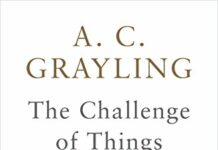
Ebook Info
- Published: 2007
- Number of pages: 400 pages
- Format: PDF
- File Size: 8.72 MB
- Authors: A. C. Grayling
Description
Was the bombing offensive [against civilians in Germany and Japan] a crime against humanity, writes A. C. Grayling, “or was it justified by the necessities of war? These questions mark one of the great remaining controversies of the Second World War.” Their resolution, which Grayling accomplishes with great respect and with a sense of urgency, is a vital contribution to the debate about how far governments can go in the name of national security.
User’s Reviews
Editorial Reviews: Review “A probing, thoughtful meditation…The excellence of Among the Dead Cities, however, rests less on Grayling’s deductions than his provision of enough information and argument for readers with alternate premises to draw different conclusions. That richness makes wrestling with his views a demanding intellectual exercise.” ―Carlin Romano, Philadelphia Inquirer“Was the indiscriminate bombing of civilians–in Hamburg, in Dresden, in Tokyo, in Hiroshima, in Nagasaki–justifiable militarily, or was it ‘in whole or in part morally wrong’?… Almost immediately one senses what [Grayling’s] answer will be–an unequivocal “Yes”–but he must be given full credit for reaching that conclusion only after a careful, nuanced analysis…If there was no military justification for the bombings, then there cannot possibly be a moral one, and Grayling’s judgment that they were immoral seems to me exceedingly difficult to refute.” ―Jonathan Yardley, Washington Post“In an age of political terror, when it is urgent to come up with a persuasive distinction between legitimate and illegitimate violence, it is hard to overstate the importance of the questions Grayling raises.” ―Fredric Smoler, American Heritage“In his timely examination of “area bombing,” which targeted civilian populations for destruction during World War II, British philosopher A.C. Grayling brings a fresh perspective to some of the great questions of modern history…and gives answers that should broaden thinking about how the United States conducts its global war on terrorism and its conflicts in Iraq and Afghanistan.” ―G. Pascal Zachary, San Francisco Chronicle“In this book, one of the world’s most passionate and articulate humanists attends to one of the twentieth-century’s largest unexploded moral conundrums…Grayling’s verdict is surprising not in ultimately condemning the attacks but in doing so in an elegantly blunt fashion that simultaneously radiates profound compassion for the perpetrators.” ―Booklist, starred review About the Author A. C. Grayling is Professor of Philosophy at Birkbeck College, University of London. He is the author of several books, among them Meditations for the Humanist, and biographies of Rene Descartes and William Hazlitt. A fellow of the World Economic Forum and past chairman of the human rights organization, June Fourth, he contributes frequently to the Financial Times and the Economist. He lives in London.
Reviews from Amazon users which were colected at the time this book was published on the website:
⭐If you travel to London, a `must’ for any tourist is Westminster Cathedral. In the apse of that famous edifice you will find a window devoted to the saviors of Britain in WW2, the men of the RAF. Most unfortunately, you find among those named one that surely needs to be effaced, Sir Arthur “Bomber” Harris. Long appalled by the muted – nay, virtually non-existent – criticism of the murderous policy of our air warfare in WW2, the `area’, or `saturation’, or `strategic’ bombings, whatever one wishes to call that atrocious, indiscriminate attempt to annihilate whole sections of cities, I approached this work with great hope that this would, at last, be definitively addressed. Indeed, in the hands of a clearly informed and prolific philosopher (see his other works), it seemed an almost ideal combination. And, his work, in the opening chapters, in elucidating the origins of this policy is exemplary, namely: the accidents triggering retaliations that ultimately spiraled out of control; the inability to hit a target with any accuracy*; the unacceptable loss rate from daylight raids (the only ones with any chance to reliably find a tactical target); the psychological need to take the fight to the enemy when all other avenues with any public impact were inaccessible; and finally, the peculiar psyche of Arthur Harris (and, possibly, Curtis LeMay, although this is somewhat less certain), who sincerely believed, due largely to his experience in WW1 and his consequent desire to avoid its repetition at any cost, that air power alone would bring surrender without the necessity of a ground assault. Grayling continues with an exhaustive summary of the legal framework of the rules of war. His outline of the various Geneva conventions and protocols is quite helpful, if sometimes anachronistic and tedious. Still, for a work of this sort, it cannot be avoided, and Grayling accepts this wearisome duty, offering it to us digested and distilled in one place, for which we must be grateful. In addition, he offers, as a substantial bonus, a unique 45 page appendix of “RAF bombing attacks on Germany, with civilian casualties… and RAF losses…”. Unfortunately, he fails to note his source, or sources, for this monumental, and crucial, enumeration. It is in the actual history, though, that the book fails (proving perhaps, if proof were still needed, that this profession does indeed require training, and that it is not, despite appearances, open and vouchsafed for all). The author, in particular, apparently does not understand the distinction between a war that is lost, and surrender. While it is doubtless true that, by the beginning of 1945, at the very latest, there was no possibility of either Germany or Japan prevailing, or even emerging from the war without defeat, there still remained the question of surrender and how the countries were to be governed after the war. Due to the horrific nature of both regimes in power during the war, there was absolutely no question by the Allies of retaining any elements whatever of those structures and personnel after the war – to do so would have rendered the enormous sacrifices of the war years as essentially meaningless. And, neither of those regimes, as they were constituted during the war, was ready at any point, however hopeless, to surrender – both were, in fact, geared to fight to the last man. That happened, in essence, in Germany. In Japan, it was avoided, but only by the – very belated – intervention of the Emperor (and then, only after an attempted coup against his holy personage was repulsed!). In fact, a good argument can be made, despite the very good, recent book by Professor Hasegawa, “Racing the Enemy”, that the Bomb was critical in his intervention. (Professor Hasegawa’s book, by the way, was subjected to serious criticism by Michael Kort, and D.M. Giangreco, among others.) You have to know what the Japanese were willing to accept for surrender, namely, the military left essentially untouched, the retention of a number of colonies, the home islands unoccupied, to understand how `unconditional’ in `unconditional surrender’ was not really excessive. You have to have intimate knowledge of the war, by living through it or reading extensively in it, to know from Iwo Jima and Okinawa just what would be expected from invading the homeland, and why, therefore, use of the Atomic Bomb was not necessarily contemptible (tho one can, certainly, argue with how it was initially used). Most egregious is his statement (undocumented), on page 154 (repeated, if abbreviated, on p. 260) that Byrnes was urging, on June 1, 1945, use of the bomb as primarily a tool against Russia, which does not fit with the man or the times. (I am assured by Professor Hasegawa, who has examined the minutes of the Interim Committee in the archives, that no such statement of that date from Byrnes exists – nor could it, as it was certainly far too early for such talk, and, I would add, impossible, even from belligerent Byrnes.) I can only assume that Grayling has consulted too much of the notoriously unreliable Gar Alperovitz – and, of that author, even one book is too much – and not enough, not nearly enough, of the best sources on the war. Lastly, I cannot refrain from commenting on the author’s equivalence of 9/11 and Aug 6, 1945 (p. 279). Can it really be that a man of this profound philosophical training does not see the difference between a pointless act of terror with no defined objective on 9/11, with Aug 6, which had a very specific and achievable – I would even say achieved – one? In sum: A work of importance, but seriously flawed – the definitive treatment awaits.* I have learned, from other sources, that the accuracy of bombing in WW2 was pathetic, despite the storied Norden bombsite, with over 50% of all bombs falling outside of a radius of 1000 feet from the putative aiming point! (Still looking for one reason we did not bomb the rails leading to the concentration camps?)
⭐I wanted to lke the book, as the author’s attempt to look at the morality of allied bombing tactics in the Second World War is laudable. The problem, however, is that the author mischaracterizes the “law” and fails to look at the campaign through the fog of war. First, the author cites over and over to “Just War Theory” requiring attacks be necessary and proportionate. This is absolutely true today, but no military lawyers required this standard in during the war. It applies today’s standards (framed with very old theology) to yesterdays actions. Not that big of a deal (may e no one else cares what contemorary lawyers thought), but the author also mischaracterizes post war treaties. He writes as if the Fourth Geneva convention prohibits bombing enemy civilian populations, when its protections do not extend that far (bombing protecting in the convention only applies to enemy civilians in occupied territory). The author also tries to say that Additional Protocol I to the 1949 conventions applies to the US as “customary internation law.” This is simply an untrue statement. The US has long objected to the “new” provisions of the protocol and has never viewed them as binding as customary international law. My second point is that when assessing the morality of the action, the author writes about actual impacts and effects in Germany. This may be reasonable in some situations, but not in war where each side struggles to know what is happening behind enemy lines. The question, not addressed in the book, is what impact did Harris think he was having on the German economy, and was he reasonable in such thinking. That would be a better question and would have resulted in a more informed answer. I have other problems with the book. For example, the allies in WWII did not see industrial workers and their families as civilians. They we seen as combatants. The author completes misses this critical point to talk about how the allies intentionally bombed civilians. This framing predetermines the moral conclusion. In summary, this author lets his advocacy undermine his objectivity and the book suffers because of it.
⭐Among The Dead Cities – A.C. Grayling The topic addressed in this book – a history of the allies deliberate WWII bombing of civilians – is, in my estimation, outrageous and repugnant and forces us to meet head-on a very disconcerting and heretofore little discussed aspect of the campaign to defeat Germany and Japan. The author’s stated purpose it to answer the question: “was the bombing offensive against civilians in Germany and Japan a crime against humanity or was it justified by the necessity of war? The book consists of two sections: one is an impartial and very well documented history and evaluation of the bombing campaign followed by a legalistic evaluation of the moral question. I leave it up to the reader to find the answer. For the record most of the book’s discussions concerns the British air war against Germany. The subject of this book fly’s in the face of the simplistic and homogenized “war histories” taught in schools and portrayed in popular media. It forced me to take a much broader and nuanced view of any military involvement for whatever reason. Ultimately their are no victors in war – just one side still standing – but at what cost? Maps, index, notes, photographs, and a 44-page appendix detailing RAF (Royal Air Force) bombing sorties, make this a valuable reference tool.
Keywords
Free Download Among the Dead Cities: The History and Moral Legacy of the WWII Bombing of Civilians in Germany and Japan (Bloomsbury Revelations) in PDF format
Among the Dead Cities: The History and Moral Legacy of the WWII Bombing of Civilians in Germany and Japan (Bloomsbury Revelations) PDF Free Download
Download Among the Dead Cities: The History and Moral Legacy of the WWII Bombing of Civilians in Germany and Japan (Bloomsbury Revelations) 2007 PDF Free
Among the Dead Cities: The History and Moral Legacy of the WWII Bombing of Civilians in Germany and Japan (Bloomsbury Revelations) 2007 PDF Free Download
Download Among the Dead Cities: The History and Moral Legacy of the WWII Bombing of Civilians in Germany and Japan (Bloomsbury Revelations) PDF
Free Download Ebook Among the Dead Cities: The History and Moral Legacy of the WWII Bombing of Civilians in Germany and Japan (Bloomsbury Revelations)





